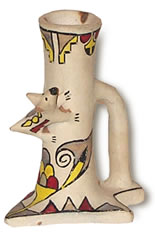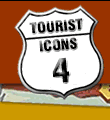 | 






|  |

Entrepreneurial Native artists innovated with new forms and styles to meet the needs of mass tourism.
They reinvented ashtrays, bookends, candlesticks, and flowerpots as sentimental merchandise that tourists
wanted to buy. As time passed, these made-for-the-tourist-trade creations became known as forms of
authentic expression.

For much of the last century, efforts to understand the Southwest have been based on the misnomer that
Native cultures were disappearing. Scholars and collectors sought to rescue "authentic" culture from
the ravages of outside influences. Anthropologists sought to salvage and document what they considered
to be pure culture. In general, art produced before the 1880s was considered authentic, while works influenced
by the collector's culture were dismissed as contaminated kitsch.
In 1926, Odd Halseth expressed these ideas succinctly in the Museum of New Mexico magazine El Palacio.
He noted that:
Santo Domingo is perhaps producing more . . . curio pottery than all other pueblos . . . due to the fact that
the pueblo is located near the transcontinental highway between Albuquerque and Santa Fe . . .. Crude
figures of very inferior workmanship are each summer sold to the white people by the thousands . . .
Ash trays, cream pitchers, book ends, spittoons, and other such articles . . . are copied in a wholesale
fashion and peddled along the highways and in nearby towns.
Odd S. Halseth, El Palacio, 1926
  
| |





